The AMD Radeon VII Review: An Unexpected Shot At The High-End
by Nate Oh on February 7, 2019 9:00 AM ESTProfessional Visualization and Rendering
With AMD strongly pushing the Radeon VII as a prosumer content creation card, it behooves us to look at rendering, CAD, and professional visualization performance. However, accurate and applicable benchmarks for this field are not so easy to find, especially since performance is highly dependent on workflow and proprietary licensed ISV software. Given AnandTech’s audience, which often includes engineers using these applications in critical production environments, our goal is to provide the most relevant metrics. However, as Ian has discussed previously, the route to the most accurate workstation benchmarking for professional applications is in the hands of ISVs, who are at best blasé and more typically negative about providing access, even at the prospect of lending limited software licenses in return for ongoing discussion and third-party benchmark data of their software.
Those caveats in mind, the next best thing for evaluating overall GPU workstation performance is the venerable SPECviewperf, recently updated to version 13. Separated into ‘viewsets,’ which are a group of application-specific workloads derived from real-world datasets, SPECviewperf has been a longstanding suite for generalized workstation/CAD GPU performance. For SPECviewperf 13, the viewsets are based on:
- Autodesk 3ds Max 2016 (Nitrous DX11 driver)
- Dassault Systèmes CATIA V6 R2012
- PTC Creo 3 & Creo 4
- Geosurvey software, with workloads based on rendering techniques utilized by the open-source OpendTect seismic visualization application
- Autodesk Maya 2017
- Radiological (i.e. CT, MRI scans) rendering, with workloads using the Tuvok rendering core of the ImageVis3D volume visualization application
- Autodesk Showcase 2013
- Siemens NX 8.0
- Dassault Systèmes Solidworks 2013 SP1
While we didn’t have time for complete benchmarking of video editing/production software such as Adobe Premiere Pro CC, we will be looking to include that in the future.
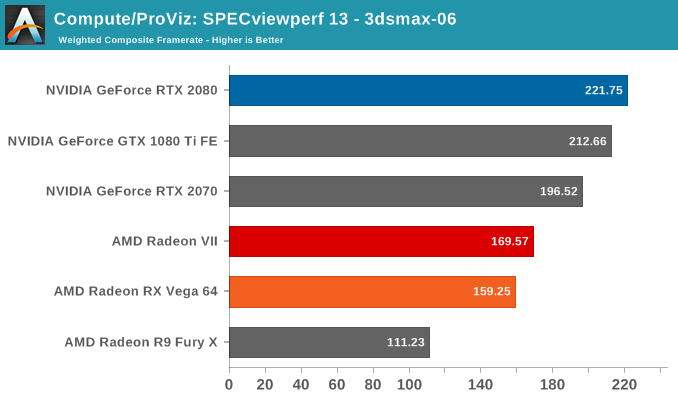
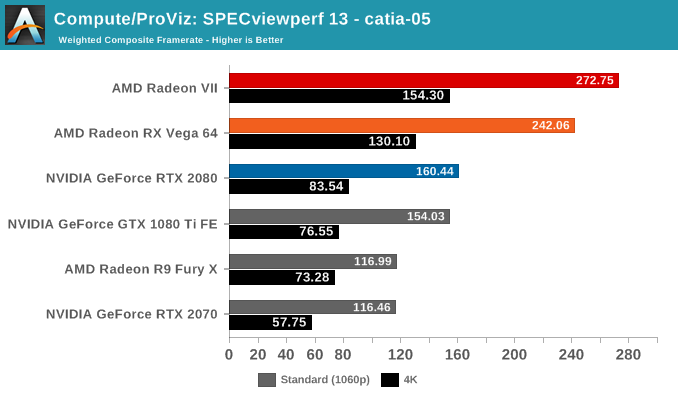

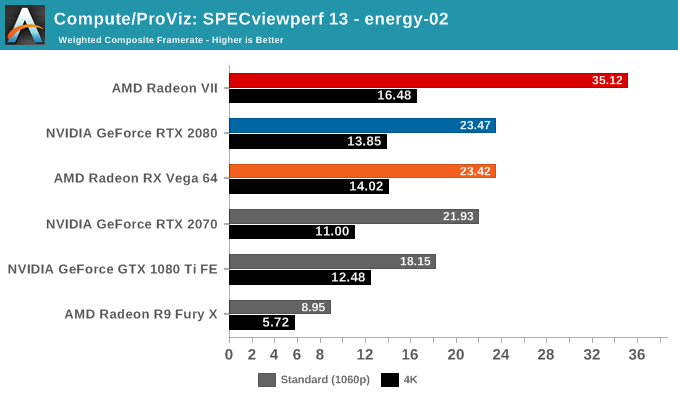
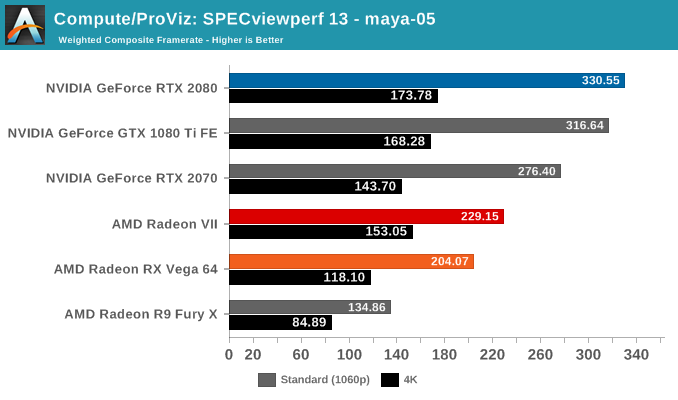
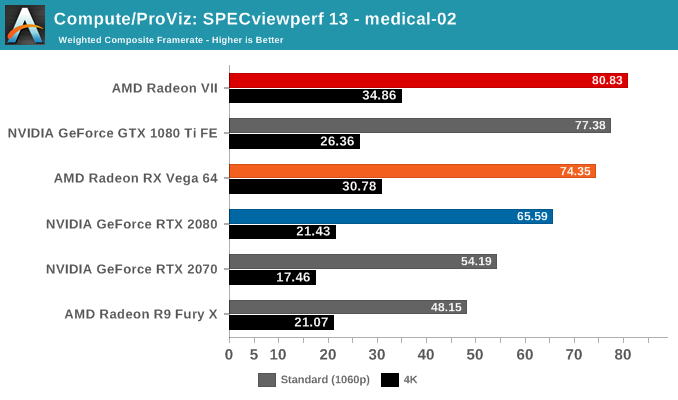
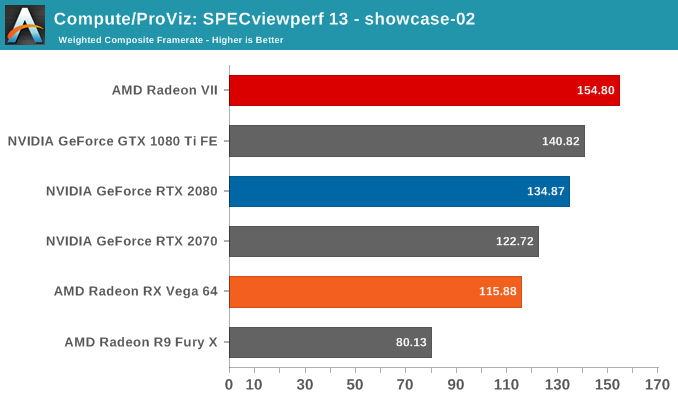
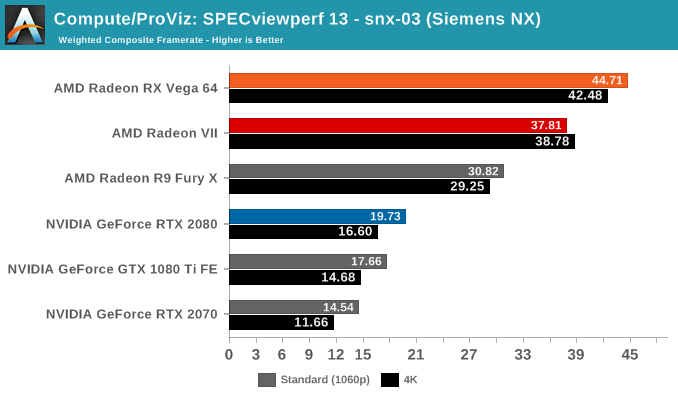
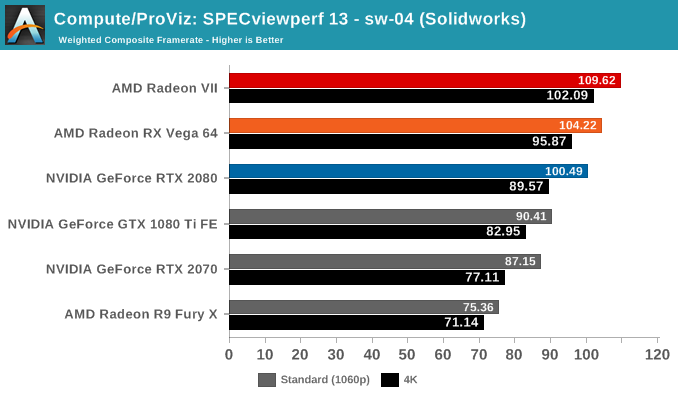
Looking over the results, it's clear that certain viewsets tend to perform better on one vendor's hardware than the other's. In those cases, the Radeon VII doesn't buck the trend, though in Siemens NX the lower performance is more likely than not related to driver maturity. In the reverse scenarios like in creo-02 or maya-05, the Radeon VII is in a similar spot, naturally ahead of the RX Vega 64 but behind the competing RTX and GTX cards. If anything, the results highlight the importance of software maturity for newer hardware, but there are definite signs of Vega 20 being a powerful workstation card. The caveat is that it doesn't seem to change the overall landscape for worksets that traditionally perform well on NVIDIA hardware.
Our next set of benchmarks look at rendering performance. To be clear, given the nature of ‘render wars’ as well as the adoption of CUDA, the featured render engines are not necessarily indicative of the overall GPU renderer landscape. Because we are looking at the Radeon VII, it’s not applicable to include some of the more popular renderers, such as Redshift and Octane, which are CUDA-only, and similarly the presence of Indigo Renderer helps as another datapoint even though it is less popular.


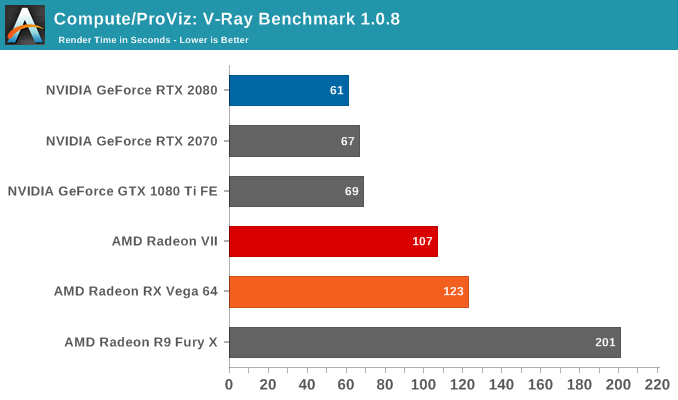

To note, official Blender releases have yet to incorporate CUDA 10, and so RTX 20 series cards are not officially supported.
V-RAY here is the only test that utilizes CUDA for NVIDIA cards, while the rest all use OpenCL. The results seem broadly similar to SPECviewperf, where the Radeon VII continues to excel at workloads where AMD hardware generally fare well.










289 Comments
View All Comments
Dr. Swag - Thursday, February 7, 2019 - link
If I had to guess, those tests probably are more dependent on memory capacity and/or memory bandwidth.Klimax - Friday, February 8, 2019 - link
Could be still difference between AMD's and Nvidia's OpenCL drivers. Nvidia only fairly recently started to focus on them. (Quite few 2.0 features are still listed as experimental)tipoo - Thursday, February 7, 2019 - link
That they changed the FP64 rate cap entirely in BIOS makes me wonder, should the iMac Pro be updated with something like this (as Navi is supposed to be launching with the mid range first), if it would have the double precision rate cap at all as Apple would be co-writing the drivers and all.tvdang7 - Thursday, February 7, 2019 - link
I feel AT needs to update the game list. I understand that these are probably easier to bench and are demanding but most of us are curious on how it performs on games we actually play. Lets be real how many of you or your friends play these game on the daily? BF1 and MAYBE GTA are popular but not on the grand scheme of things .Manch - Thursday, February 7, 2019 - link
7 DX 111 DX 12
1 Vulcan
Need a better spread of the API's and denote which games are engineered specifically for AMD or Nvidia or neither. I think that would be helpful when deciding which card should be in your rig.
TheinsanegamerN - Thursday, February 7, 2019 - link
Perhaps tell game developers to get with the times then? You cant test what isnt there, and the vast majority of games with repeatable benchmarks are DX11 titles. That is not Anandtech's fault.Manch - Friday, February 8, 2019 - link
Didn't say it was. Merely a suggestion/request. There are around 30 games that are released with DX 12 support and about a dozen with Vulkan. Some of the DX 11 titles tested for this review offer DX 12 & Vulkan supt. They exist and can be tested. If there is a reason to NOT test a DX version or Vulkan version, for example RE2's broken DX12 implementation, OK fair enough. I think it would offer a better picture of how each card performs overall.Manch - Friday, February 8, 2019 - link
DX11 DX12 Vulkan
BF1 Tested Yes No
FC5 Tested No No
AotS Yes Tested Yes
Wolf Yes Yes Tested
FF Tested Maybe? No
GTA Tested No No
SoW Tested No No
F1 Tested No No
TW Tested Yes No
4 of the games tested with DX11 have DX 12 implementations and AotS has a Vulkan implementation. If the implementation is problematic, fair enough. Put a foot note or a ** but there are games with DX 12 and Vulkan out there on current engines so it can be done.
Ryan, perhaps and article on the games, the engines, their API implementations and how/why you choose to use/not use them in testing? Think it would be a good read.
Manch - Friday, February 8, 2019 - link
Sorry bout the format didn't realize it would do that to it.eddman - Friday, February 8, 2019 - link
"about a dozen with Vulkan"What are these dozen games? Last time I checked there were only three or four modern games suitable for vulkan benchmarking: Wolfenstein 2, Doom, Strange Brigade and perhaps AotS.
IMO Wolfenstein 2 is enough to represent vulkan.
"Wolf Yes Yes Tested"
Wolfenstein 2 is vulkan only; no DX12.
As for DX12, yes, I too think they could add more.